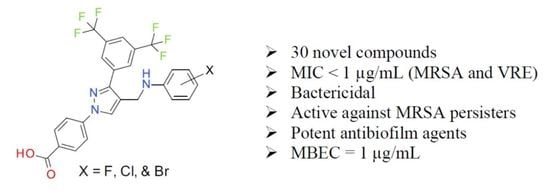Synthesis of 3,5-Bis(trifluoromethyl)phenyl-Substituted Pyrazole Derivatives as Potent Growth Inhibitors of Drug-Resistant Bacteria
Abstract
:1. Introduction
2. Results and Discussion
2.1. Cytotoxicity Studies
2.2. Time Kill Assay
2.3. Activity against Persisters
2.4. Activity against S. aureus and E. faecalis Biofilms
3. Procedures
3.1. General Consideration
3.2. Synthesis of 3,5-Bis(trifluoromethyl)phenyl-derived Pyrazole Aldehyde (III)
3.3. Synthesis of 3,5-Bis(trifluoromethyl)phenyl Substituted Pyrazole-Derived Anilines (1–30)
3.4. Compound Characterization Data
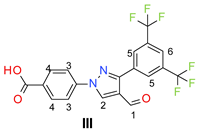

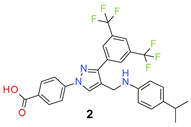
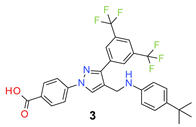
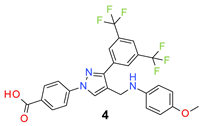

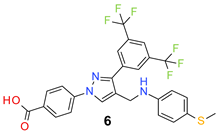

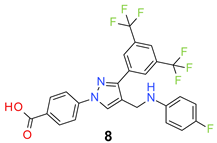

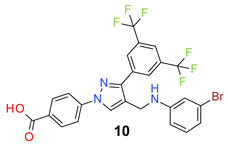
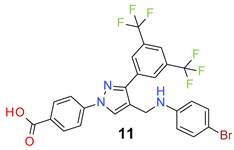
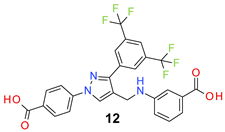
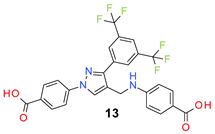
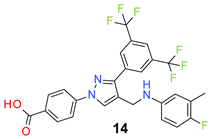
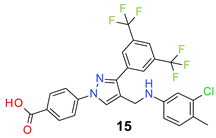
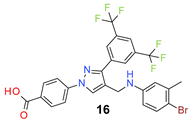

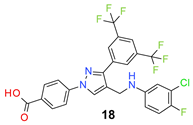

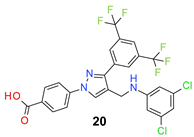
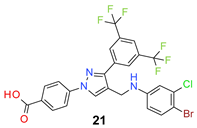
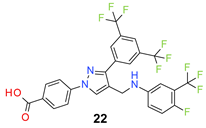




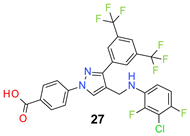
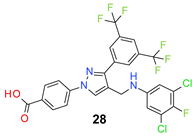
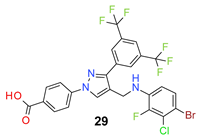

3.5. Minimum Inhibitory Concentration Assay (MIC)
3.6. Cytotoxicity Assay
3.7. Time Kill Assay
3.8. Persister Assay
3.9. Calgary Biofilm Device
4. Conclusions
Supplementary Materials
Author Contributions
Funding
Institutional Review Board Statement
Informed Consent Statement
Data Availability Statement
Acknowledgments
Conflicts of Interest
Sample Availability
References
- Oliveira, D.M.P.D.; Forde, B.M.; Kidd, T.J.; Harris, P.N.A.; Schembri, M.A.; Beatson, S.A.; Paterson, D.L.; Walker, M.J. Antimicrobial Resistance in ESKAPE Pathogens. Clin. Microbiol. Rev. 2020, 33, e00181-19. [Google Scholar] [CrossRef] [PubMed]
- Agudelo Higuita, N.I.; Huycke, M.M. Enterococcal Disease, Epidemiology, and Implications for Treatment. In Enterococci: From Commensals to Leading Causes of Drug Resistant Infection; Gilmore, M.S., Clewell, D.B., Ike, Y., Shankar, N., Eds.; Massachusetts Eye and Ear Infirmary: Boston, MA, USA, 2014. [Google Scholar]
- CDC Vancomycin-Resistant Enterococci (VRE). Available online: https://www.cdc.gov/drugresistance/pdf/threats-report/vre-508.pdf (accessed on 23 May 2020).
- Ch’ng, J.-H.; Chong, K.K.L.; Lam, L.N.; Wong, J.J.; Kline, K.A. Biofilm-Associated Infection by Enterococci. Nat. Rev. Microbiol. 2019, 17, 82–94. [Google Scholar] [CrossRef] [PubMed]
- Pidot, S.J.; Gao, W.; Buultjens, A.H.; Monk, I.R.; Guerillot, R.; Carter, G.P.; Lee, J.Y.H.; Lam, M.M.C.; Grayson, M.L.; Ballard, S.A.; et al. Increasing Tolerance of Hospital Enterococcus Faecium to Handwash Alcohols. Sci. Transl. Med. 2018, 10, eaar6115. [Google Scholar] [CrossRef] [Green Version]
- CDC General Information about Staphylococcus Aureus. Available online: https://www.cdc.gov/hai/organisms/staph.html (accessed on 15 July 2021).
- Craft, K.M.; Nguyen, J.M.; Berg, L.J.; Townsend, S.D. Methicillin-Resistant Staphylococcus Aureus (MRSA): Antibiotic-Resistance and the Biofilm Phenotype. Medchemcomm 2019, 10, 1231–1241. [Google Scholar] [CrossRef]
- Mistry, T.L.; Truong, L.; Ghosh, A.K.; Johnson, M.E.; Mehboob, S. Benzimidazole-Based FabI Inhibitors: A Promising Novel Scaffold for Anti-staphylococcal Drug Development. ACS Infect. Dis. 2017, 3, 54–61. [Google Scholar] [CrossRef] [Green Version]
- Moisse, K. Antibiotic Resistance Could Bring ‘End of Modern Medicine’. Available online: http://abcnews.go.com/blogs/health/2012/03/16/antibiotic-resistance-could-bring-end-of-modern-medicine/ (accessed on 1 May 2020).
- Naim, M.J.; Alam, O.; Nawaz, F.; Alam, M.J.; Alam, P. Current Status of Pyrazole and Its Biological Activities. J. Pharm. Bioallied. Sci. 2016, 8, 2–17. [Google Scholar]
- Steinbach, G.; Lynch, P.M.; Phillips, R.K.S.; Wallace, M.H.; Hawk, E.; Gordon, G.B.; Wakabayashi, N.; Saunders, B.; Shen, Y.; Fujimura, T.; et al. The Effect of Celecoxib, a Cyclooxygenase-2 Inhibitor, in Familial Adenomatous Polyposis. N. Engl. J. Med. 2000, 342, 1946–1952. [Google Scholar] [CrossRef]
- Hampp, C.; Hartzema, A.G.; Kauf, T.L. Cost-Utility Analysis of Rimonabant in the Treatment of Obesity. Value Health 2008, 11, 389–399. [Google Scholar] [CrossRef] [PubMed] [Green Version]
- Kameyama, T.; Nabeshima, T. Effects of 1,3-Diphenyl-5-(2-Dimethylaminopropionamide)-Pyrazole[Difenamizole] on a Conditioned Avoidance-Response. Neuropharmacology 1978, 17, 249–256. [Google Scholar] [PubMed]
- Dalvie, D.K.; Kalgutkar, A.S.; Khojasteh-Bakht, S.C.; Obach, R.S.; O’Donnell, J.P. Biotransformation Reactions of Five-Membered Aromatic Heterocyclic Rings. Chem. Res. Toxicol. 2002, 15, 269–299. [Google Scholar] [CrossRef] [PubMed]
- Chen, L.W.; Wang, P.F.; Tang, D.J.; Tao, X.X.; Man, R.J.; Qiu, H.Y.; Wang, Z.C.; Xu, C.; Zhu, H.L. Metronidazole Containing Pyrazole Derivatives Potently Inhibit Tyrosyl-tRNA Synthetase: Design, Synthesis, and Biological Evaluation. Chem. Biol. Drug. Des. 2016, 88, 592–598. [Google Scholar] [CrossRef]
- Hafez, H.N.; El-Gazzar, A.R.; Al-Hussain, S.A. Novel Pyrazole Derivatives with Oxa/Thiadiazolyl, Pyrazolyl Moieties and Pyrazolo [4,3-d]-Pyrimidine Derivatives as Potential Antimicrobial and Anticancer Agents. Bioorg. Med. Chem. Lett. 2016, 26, 2428–2433. [Google Scholar] [CrossRef] [PubMed]
- Nayak, N.; Ramprasad, J.; Dalimba, U. New INH-Pyrazole Analogs: Design, Synthesis and Evaluation of Antitubercular and Antibacterial Activity. Bioorg. Med. Chem. Lett. 2015, 25, 5540–5545. [Google Scholar] [CrossRef]
- Allison, D.; Delancey, E.; Ramey, H.; Williams, C.; Alsharif, Z.A.; Al-khattabi, H.; Ontko, A.; Gilmore, D.; Alam, M.A. Synthesis and Antimicrobial Studies of Novel Derivatives of 4-(4-formyl-3-phenyl-1H-pyrazol-1-yl)Benzoic Acid as Potent Anti-Acinetobacter Baumannii Agents. Bioorg. Med. Chem. Lett. 2017, 27, 387–392. [Google Scholar] [CrossRef] [PubMed] [Green Version]
- Zakeyah, A.A.; Whitt, J.; Duke, C.; Gilmore, D.F.; Meeker, D.G.; Smeltzer, M.S.; Alam, M.A. Synthesis and Antimicrobial Studies of Hydrazone Derivatives of 4-[3-(2,4-Difluorophenyl)-4-formyl-1H-pyrazol-1-yl]benzoic acid and 4-[3-(3,4-difluorophenyl)-4-formyl-1H-Pyrazol-1-yl]Benzoic Acid. Bioorg. Med. Chem. Lett. 2018, 28, 2914–2919. [Google Scholar] [CrossRef] [PubMed]
- Whitt, J.; Duke, C.; Sumlin, A.; Chambers, S.A.; Alnufaie, R.; Gilmore, D.; Fite, T.; Basnakian, A.G.; Alam, M.A. Synthesis of Hydrazone Derivatives of 4-[4-Formyl-3-(2-oxochromen-3-yl)pyrazol-1-yl]Benzoic acid as Potent Growth Inhibitors of Antibiotic-Resistant Staphylococcus Aureus and Acinetobacter Baumannii. Molecules 2019, 24, 2051. [Google Scholar] [CrossRef] [Green Version]
- Brider, J.; Rowe, T.; Gibler, D.J.; Gottsponer, A.; Delancey, E.; Branscum, M.D.; Ontko, A.; Gilmore, D.; Alam, M.A. Synthesis and antimicrobial studies of azomethine and N-arylamine derivatives of 4-(4-formyl-3-phenyl-1H-pyrazol-1-yl)Benzoic Acid as Potent Anti-Methicillin-Resistant Staphylococcus Aureus Agents. Med. Chem. Res. 2016, 25, 2691–2697. [Google Scholar] [CrossRef]
- Whitt, J.; Duke, C.; Ali, M.A.; Chambers, S.A.; Khan, M.M.K.; Gilmore, D.; Alam, M.A. Synthesis and Antimicrobial Studies of 4-[3-(3-Fluorophenyl)-4-formyl-1H-Pyrazol-1-yl]Benzoic Acid and 4-[3-(4-Fluorophenyl)-4-formyl-1H-pyrazol-1-yl]benzoic Acid as Potent Growth Inhibitors of Drug-Resistant Bacteria. ACS Omega 2019, 4, 14284–14293. [Google Scholar] [CrossRef] [Green Version]
- Ahn, M.; Gunasekaran, P.; Rajasekaran, G.; Kim, E.Y.; Lee, S.-J.; Bang, G.; Cho, K.; Hyun, J.-K.; Lee, H.-J.; Jeon, Y.H.; et al. Pyrazole Derived Ultra-Short Antimicrobial Peptidomimetics with Potent Anti-Biofilm Activity. Eur. J. Med. Chem. 2017, 125, 551–564. [Google Scholar] [CrossRef]
- Khan, M.F.; Alam, M.M.; Verma, G.; Akhtar, W.; Akhter, M.; Shaquiquzzaman, M. The Therapeutic Voyage of Pyrazole and its Analogs: A Review. Eur. J. Med. Chem. 2016, 120, 170–201. [Google Scholar] [CrossRef]
- Sidhartha, S.K.; Cinu, A.T. Strategically Placed Trifluoromethyl Substituent in the Realm of Antitubercular Drug Design. Curr. Drug Ther. 2019, 14, 114–123. [Google Scholar]
- Keam, S.J.; Scott, L.J. Dutasteride: A Review of its Use in the Management of Prostate Disorders. Drugs 2008, 68, 463–485. [Google Scholar] [CrossRef]
- Shang, Z.; Li, Y.; Zhang, M.; Tian, J.; Han, R.; Shyr, C.R.; Messing, E.; Yeh, S.; Niu, Y.; Chang, C. Antiandrogen Therapy with Hydroxyflutamide or Androgen Receptor Degradation Enhancer ASC-J9 Enhances BCG Efficacy to Better Suppress Bladder Cancer Progression. Mol. Cancer Ther. 2015, 14, 2586–2594. [Google Scholar] [CrossRef] [PubMed] [Green Version]
- Junaid, Z.; Patel, J. Cinacalcet; StatPearls: Treasure Island, FL, USA, 2021. [Google Scholar]
- Hansa, R.K.C.; Khan, M.M.K.; Frangie, M.M.; Gilmore, D.F.; Shelton, R.S.; Savenka, A.V.; Basnakian, A.G.; Shuttleworth, S.L.; Smeltzer, M.S.; Alam, M.A. 4-4-(Anilinomethyl)-3-[4-(trifluoromethyl)phenyl]-1H-Pyrazol-1-Ylbenzoic Acid Derivatives as Potent Anti-Gram-Positive Bacterial Agents. Eur. J. Med. Chem. 2021, 219, 113402. [Google Scholar] [CrossRef]
- Alnufaie, R.; Kc, H.R.; Alsup, N.; Whitt, J.; Chambers, S.A.; Gilmore, D.; Alam, M.A. Synthesis and Antimicrobial Studies of Coumarin-Substituted Pyrazole Derivatives as Potent Anti-Staphylococcus Aureus Agents. Molecules 2020, 25, 2758. [Google Scholar] [CrossRef]
- Alnufaie, R.; Alsup, N.; Kc, H.R.; Newman, M.; Whitt, J.; Chambers, S.A.; Gilmore, D.; Alam, M.A. Design and Synthesis of 4-[4-formyl-3-(2-naphthyl)pyrazol-1-yl]benzoic Acid Derivatives as Potent Growth Inhibitors of Drug-Resistant Staphylococcus aureus. J. Antibiot. 2020, 73, 818–827. [Google Scholar] [CrossRef]
- Delancey, E.; Allison, D.; KC, H.R.; Gilmore, D.F.; Fite, T.; Basnakian, A.G.; Alam, M.A. Synthesis of 4,4-(4-Formyl-1H-pyrazole-1,3-diyl)dibenzoic Acid Derivatives as Narrow Spectrum Antibiotics for the Potential Treatment of Acinetobacter Baumannii Infections. Antibiotics 2020, 9, 650. [Google Scholar] [CrossRef]
- Scheper, H.; Wubbolts, J.M.; Verhagen, J.A.M.; de Visser, A.W.; van der Wal, R.J.P.; Visser, L.G.; de Boer, M.G.J.; Nibbering, P.H. SAAP-148 Eradicates MRSA Persisters Within Mature Biofilm Models Simulating Prosthetic Joint Infection. Front. Microbiol. 2021, 12, 625952. [Google Scholar] [CrossRef] [PubMed]
- Kim, W.; Zou, G.; Hari, T.P.A.; Wilt, I.K.; Zhu, W.; Galle, N.; Faizi, H.A.; Hendricks, G.L.; Tori, K.; Pan, W.; et al. A Selective Membrane-Targeting Repurposed Antibiotic with Activity against Persistent Methicillin-resistantstaphylococcus Aureus. Proc. Natl. Acad. Sci. USA 2019, 116, 16529–16534. [Google Scholar] [CrossRef] [Green Version]
- Kim, W.; Zhu, W.; Hendricks, G.L.; Van Tyne, D.; Steele, A.D.; Keohane, C.E.; Fricke, N.; Conery, A.L.; Shen, S.; Pan, W.; et al. A New Class of Synthetic Retinoid Antibiotics Effective against Bacterial Persisters. Nature 2018, 556, 103–107. [Google Scholar] [CrossRef]
- Methods for Dilution Antimicrobial Susceptibility Tests for Bacteria that Grow Aerobically. CLSI Approved Standards M7-A11. Clinical and Laboratory Standards Institute, Wayne, 2018. Available online: https://clsi.org/media/1928/m07ed11_sample.pdf (accessed on 26 March 2020).
- Garrison, A.T.; Abouelhassan, Y.; Kallifidas, D.; Tan, H.; Kim, Y.S.; Jin, S.; Luesch, H.; Huigens, R.W. An Efficient Buchwald–Hartwig/Reductive Cyclization for the Scaffold Diversification of Halogenated Phenazines: Potent Antibacterial Targeting, Biofilm Eradication, and Prodrug Exploration. J. Med. Chem. 2018, 61, 3962–3983. [Google Scholar] [CrossRef] [PubMed]
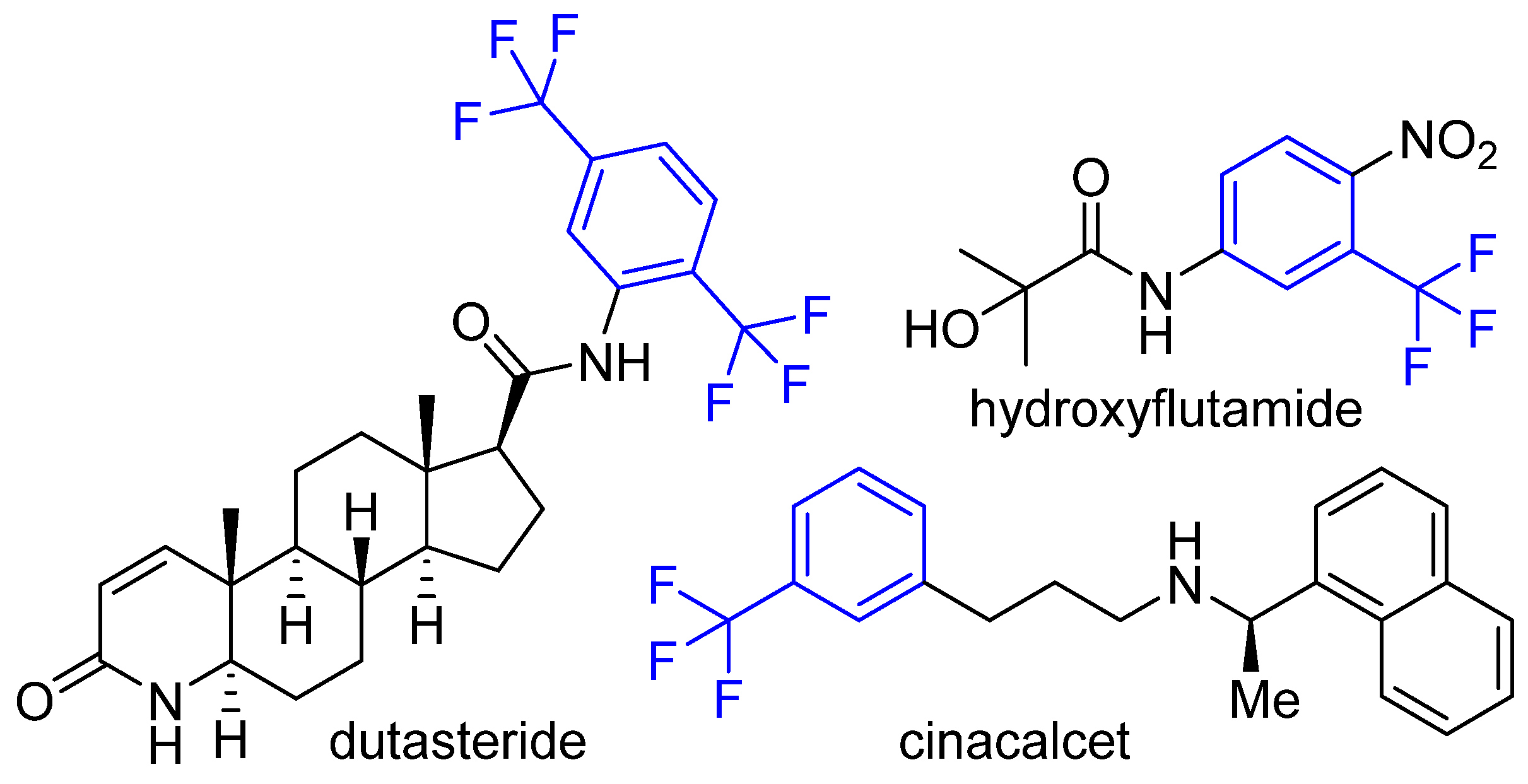
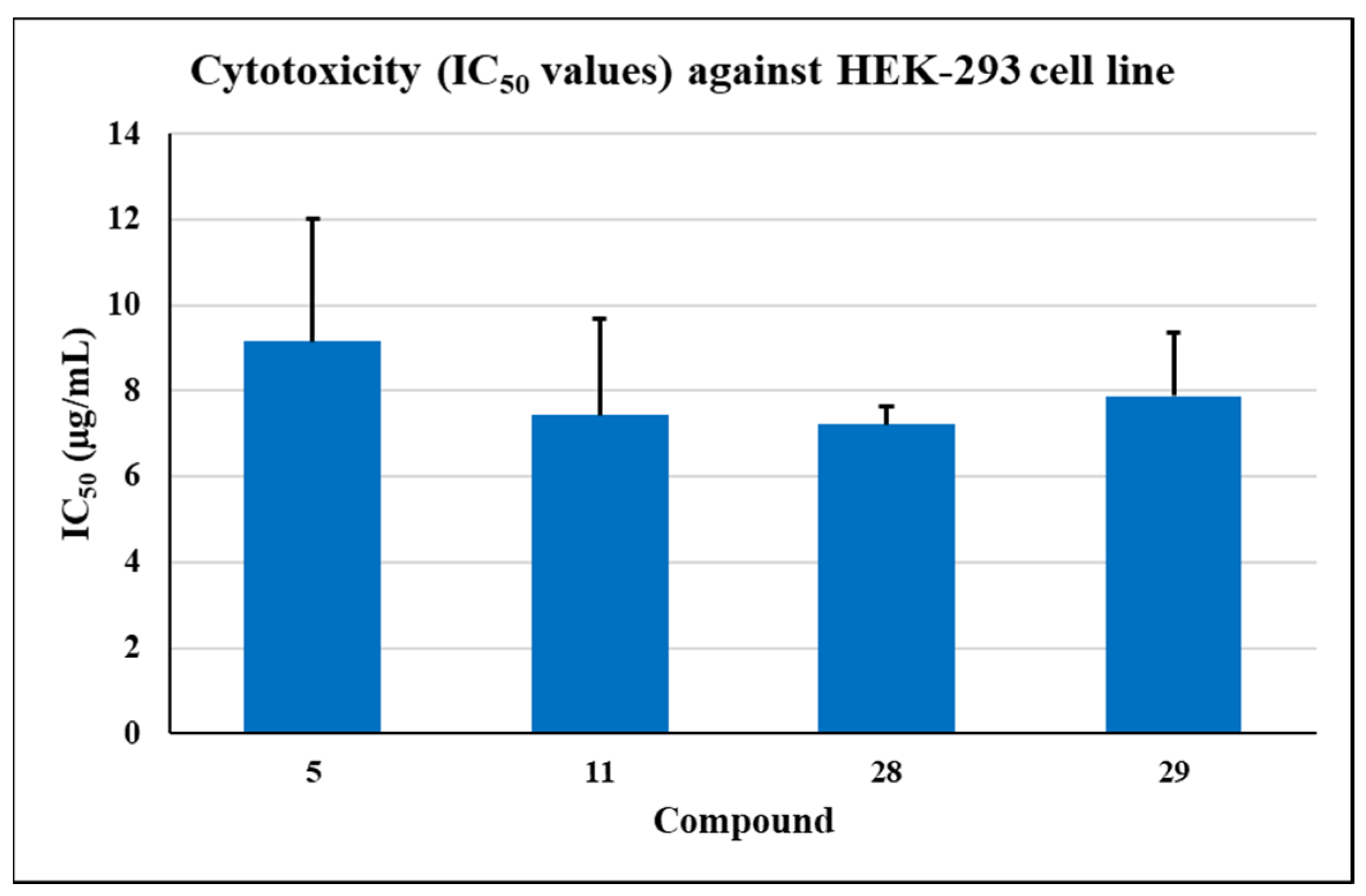
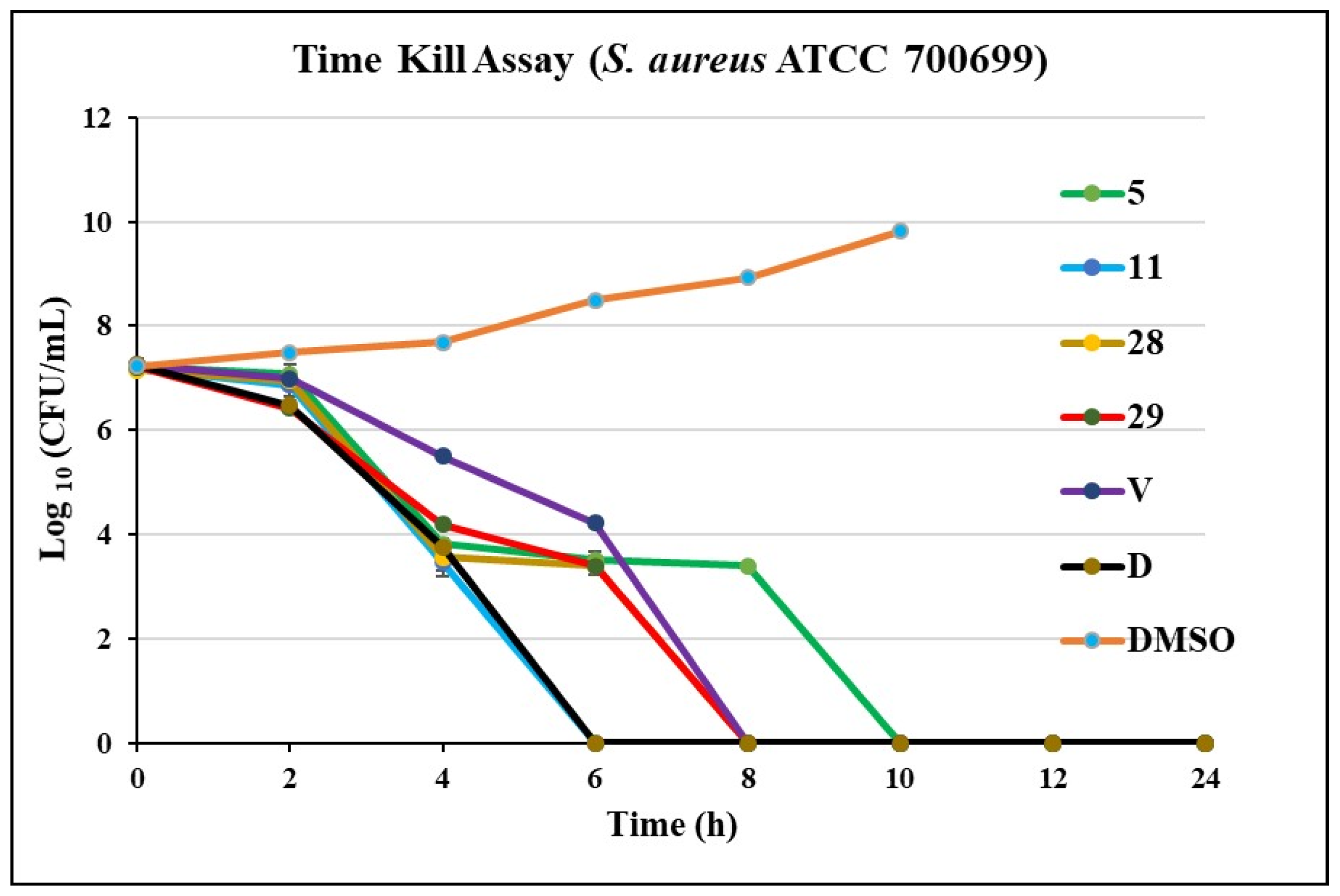
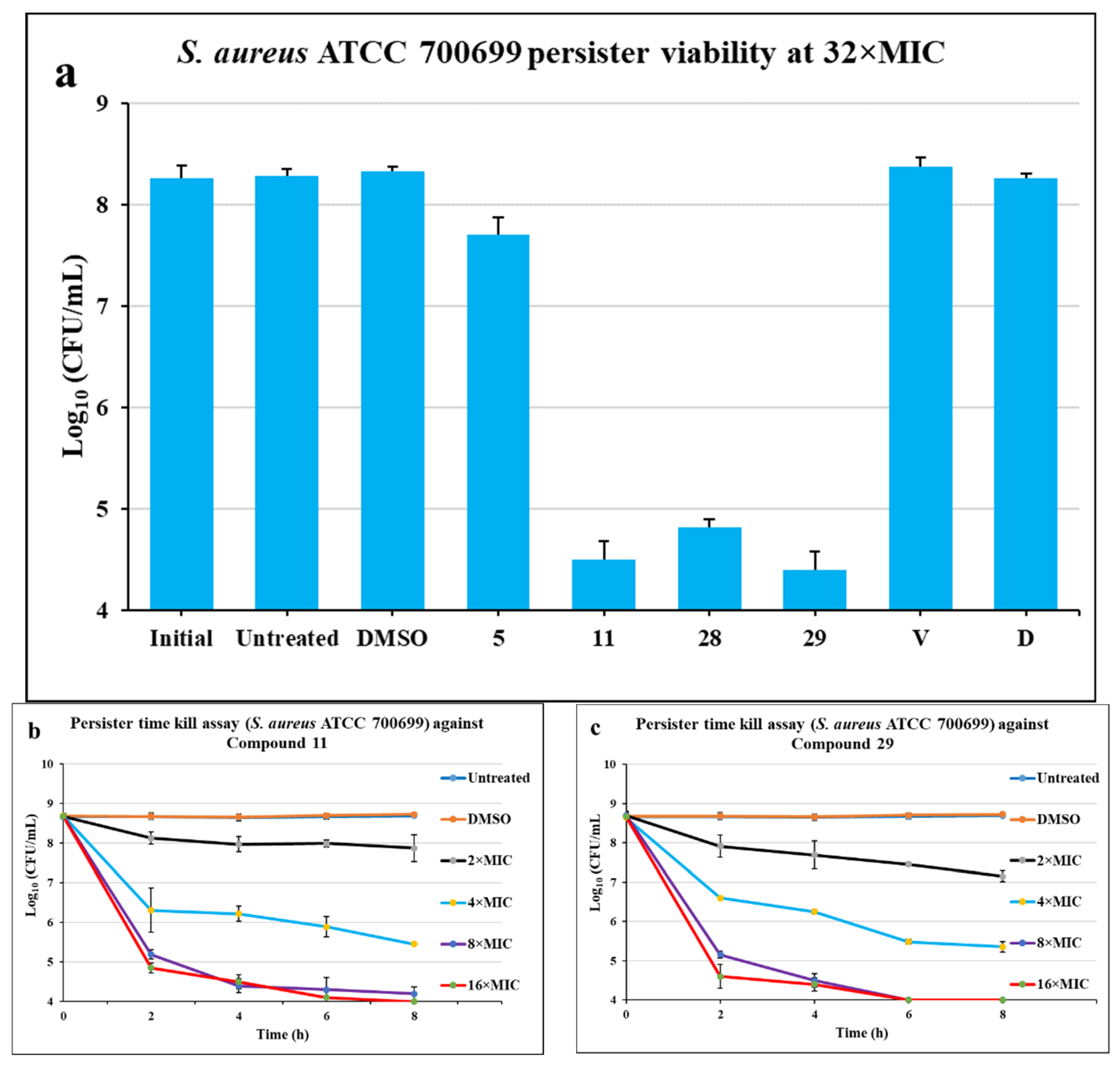
 | |||||||
| # | R | HRMS (M + H)+ | Yield (%) | # | R | HRMS (M + H)+ | Yield (%) |
| 1 |  | 506.1291 | 86 | 16 |  | 598.0553 | 82 |
| 2 |  | 548.1761 | 80 | 17 |  | 542.1122 | 83 |
| 3 |  | 562.1919 | 93 | 18 |  | 558.0816 | 90 |
| 4 |  | 536.1397 | 77 | 19 |  | 560.0776 | 86 |
| 5 |  | 598.1556 | 79 | 20 |  | 574.0509 | 85 |
| 6 |  | 552.1173 | 70 | 21 |  | 619.9990 | 92 |
| 7 |  | 524.1208 | 82 | 22 |  | 592.1082 | 86 |
| 8 |  | 524.1200 | 84 | 23 |  | 652.0280 | 83 |
| 9 |  | 540.0907 | 72 | 24 |  | 560.1030 | 77 |
| 10 |  | 584.0410 | 85 | 25 |  | 560.1026 | 76 |
| 11 |  | 584.0408 | 78 | 26 |  | 576.0721 | 83 |
| 12 |  | 550.1194 | 83 | 27 |  | 576.0729 | 69 |
| 13 |  | 550.1197 | 82 | 28 |  | 592.0402 | 90 |
| 14 |  | 538.1356 | 92 | 29 |  | 637.9897 | 88 |
| 15 |  | 554.1065 | 81 | 30 |  | 610.0322 | 67 |
| # | Sa23 | Sa12 | Sa91 | Sa92 | Sa99 | Se | Ef12 | Ef99 | Ef21 | Bs |
|---|---|---|---|---|---|---|---|---|---|---|
| 1 | 4 | 2 | 4 | 4 | 4 | 8 | 8 | 4 | 4 | 2 |
| 2 | 2 | 1 | 1 | 1 | 2 | 2 | 2 | 1 | 1 | 1 |
| 3 | 1 | 1 | 1 | 2 | 2 | 1 | 1 | 0.5 | 2 | 2 |
| 4 | 8 | 4 | 8 | 8 | 8 | 16 | 16 | 16 | 8 | 4 |
| 5 | 1 | 2 | 1 | 1 | 2 | 4 | 2 | 1 | 1 | 2 |
| 6 | 2 | 2 | 2 | 2 | 4 | 4 | 4 | 2 | 2 | 1 |
| 7 | 4 | 2 | 4 | 2 | 4 | 4 | 8 | 4 | 4 | 2 |
| 8 | 2 | 2 | 2 | 2 | 4 | 4 | 4 | 4 | 4 | 1 |
| 9 | 2 | 1 | 2 | 1 | 2 | 2 | 2 | 2 | 2 | 1 |
| 10 | 2 | 2 | 2 | 2 | 2 | 4 | 4 | 2 | 4 | 2 |
| 11 | 2 | 1 | 1 | 1 | 2 | 2 | 2 | 1 | 1 | 1 |
| 12 | >32 | >32 | >32 | >32 | >32 | >32 | >32 | >32 | >32 | >32 |
| 13 | >32 | 32 | >32 | >32 | >32 | >32 | >32 | >32 | >32 | >32 |
| 14 | 2 | 1 | 2 | 1 | 2 | 4 | 2 | 2 | 1 | 1 |
| 15 | 2 | 1 | 1 | 2 | 2 | 2 | 2 | 2 | 1 | 1 |
| 16 | 1 | 1 | 1 | 1 | 2 | 2 | 1 | 2 | 1 | 1 |
| 17 | 2 | 2 | 2 | 2 | 2 | 4 | 4 | 4 | 2 | 1 |
| 18 | 2 | 1 | 1 | 1 | 2 | 2 | 2 | 2 | 1 | 1 |
| 19 | 1 | 0.5 | 0.5 | 1 | 2 | 1 | 1 | 1 | 1 | 1 |
| 20 | 1 | 1 | 0.5 | 1 | 1 | 2 | 1 | 1 | 1 | 1 |
| 21 | 1 | 1 | 0.5 | 0.5 | 2 | 2 | 1 | 1 | 1 | 1 |
| 22 | 1 | 1 | 1 | 1 | 1 | 2 | 2 | 2 | 1 | 2 |
| 23 | 1 | 2 | 1 | 1 | 2 | 4 | 2 | 2 | 2 | 1 |
| 24 | 2 | 1 | 1 | 1 | 2 | 4 | 2 | 2 | 1 | 1 |
| 25 | 4 | 2 | 2 | 2 | 4 | 4 | 4 | 4 | 2 | 1 |
| 26 | 2 | 0.25 | 2 | 1 | 1 | 4 | 1 | 2 | 0.25 | 0.25 |
| 27 | 1 | 1 | 1 | 1 | 2 | 2 | 2 | 2 | 1 | 1 |
| 28 | 1 | 1 | 1 | 1 | 1 | 2 | 2 | 2 | 1 | 1 |
| 29 | 2 | 1 | 1 | 1 | 2 | 2 | 2 | 2 | 1 | 2 |
| 30 | 1 | 2 | 1 | 1 | 2 | 2 | 2 | 2 | 1 | 1 |
| V | 1 | 0.5 | 2 | 2 | 4 | 2 | 2 | >32 | >32 | 0.25 |
| D | 2 | 2 | 2 | 2 | 8 | 2 | 16 | 16 | 16 | 2 |
| # | MBEC (µg/mL) | |
|---|---|---|
| Sa23 | Efs12 | |
| 5 | >32 | >32 |
| 11 | 2 | 4 |
| 28 | 1 | 2 |
| 29 | 2 | 2 |
| V | >32 | >32 |
| D | >32 | >32 |
Publisher’s Note: MDPI stays neutral with regard to jurisdictional claims in published maps and institutional affiliations. |
© 2021 by the authors. Licensee MDPI, Basel, Switzerland. This article is an open access article distributed under the terms and conditions of the Creative Commons Attribution (CC BY) license (https://creativecommons.org/licenses/by/4.0/).
Share and Cite
Alkhaibari, I.S.; KC, H.R.; Roy, S.; Abu-gazleh, M.K.; Gilmore, D.F.; Alam, M.A. Synthesis of 3,5-Bis(trifluoromethyl)phenyl-Substituted Pyrazole Derivatives as Potent Growth Inhibitors of Drug-Resistant Bacteria. Molecules 2021, 26, 5083. https://doi.org/10.3390/molecules26165083
Alkhaibari IS, KC HR, Roy S, Abu-gazleh MK, Gilmore DF, Alam MA. Synthesis of 3,5-Bis(trifluoromethyl)phenyl-Substituted Pyrazole Derivatives as Potent Growth Inhibitors of Drug-Resistant Bacteria. Molecules. 2021; 26(16):5083. https://doi.org/10.3390/molecules26165083
Chicago/Turabian StyleAlkhaibari, Ibrahim S., Hansa Raj KC, Subrata Roy, Mohd. K. Abu-gazleh, David F. Gilmore, and Mohammad A. Alam. 2021. "Synthesis of 3,5-Bis(trifluoromethyl)phenyl-Substituted Pyrazole Derivatives as Potent Growth Inhibitors of Drug-Resistant Bacteria" Molecules 26, no. 16: 5083. https://doi.org/10.3390/molecules26165083
APA StyleAlkhaibari, I. S., KC, H. R., Roy, S., Abu-gazleh, M. K., Gilmore, D. F., & Alam, M. A. (2021). Synthesis of 3,5-Bis(trifluoromethyl)phenyl-Substituted Pyrazole Derivatives as Potent Growth Inhibitors of Drug-Resistant Bacteria. Molecules, 26(16), 5083. https://doi.org/10.3390/molecules26165083






